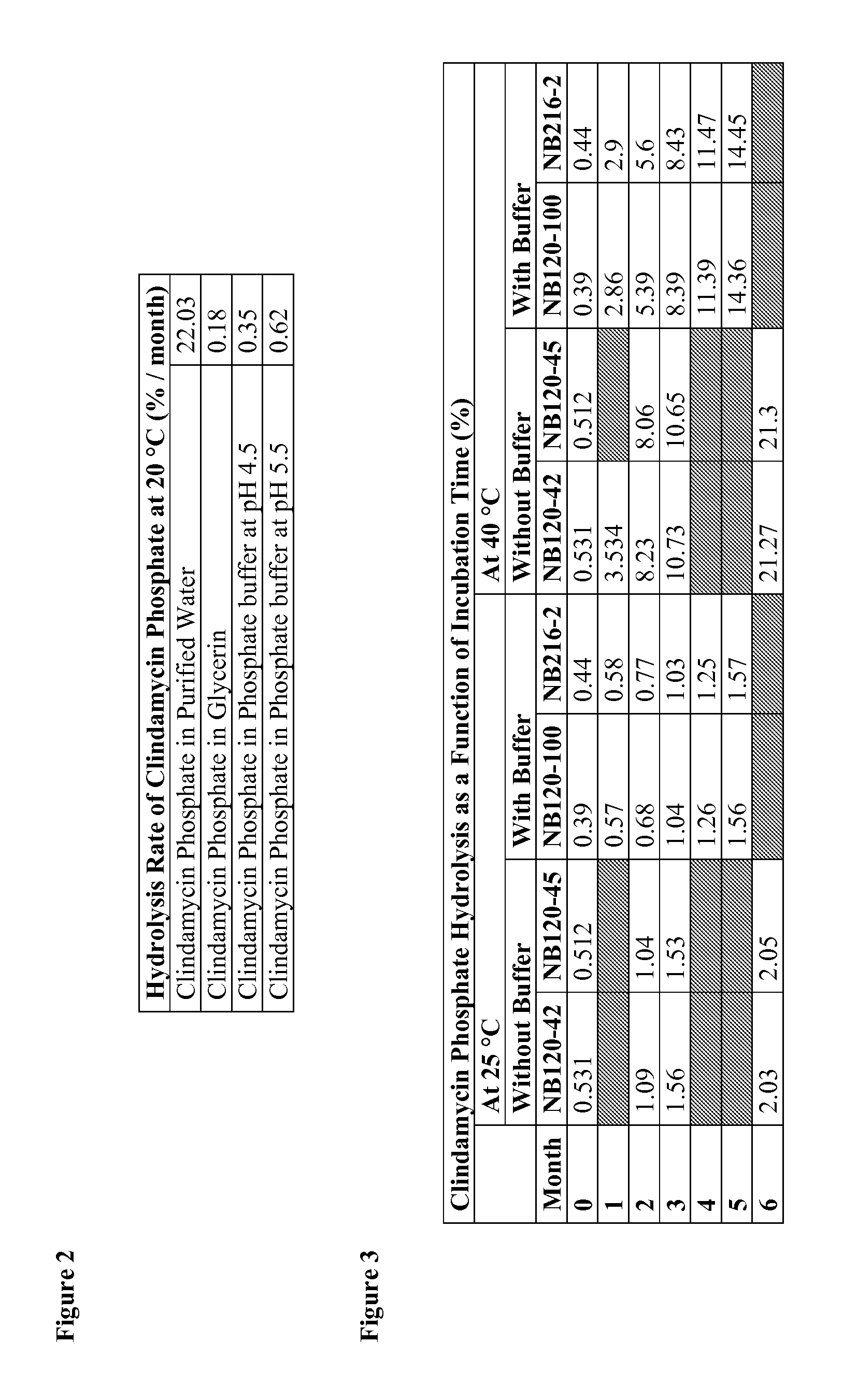Aerosol foams comprising clindamycin phosphate
a technology of clindamycin and foam, which is applied in the direction of aerosol delivery, drug composition, antibacterial agents, etc., can solve the problems of product undesirable properties, second infection, and scar formation
- Summary
- Abstract
- Description
- Claims
- Application Information
AI Technical Summary
Benefits of technology
Problems solved by technology
Method used
Image
Examples
example 1
Compositions and Method of Manufacture
[0281]An example product concentrate (NB216-2) was manufactured by the procedure outlined below:
Step 1: Oil Phase Preparation
[0282]1. Charge emulsifying wax, steareth-10, cetearyl alcohol and dimethicone into a Stainless Steel tank and heat to about 75-about 80° C.
Step 2: Aqueous Phase Preparation[0283]1. Charge purified water (Part A) and glycerin into a Stainless Steel tank and heat to about 75-about 80° C.[0284]2. Charge and dissolve methyl paraben, propyl paraben, disodium EDTA and sodium phosphate monobasic while mixing.[0285]3. Continue mixing until a clear solution is obtained while maintaining a temperature of about 75-about 80° C.
Step 3: Drug Phase Preparation[0286]1. Charge purified water (Part B) into stainless steel tank[0287]2. Dissolve Clindamycin Phosphate while mixing
Step 4: Final Emulsion Formation[0288]1. Add Step 1 to Step 2 while high-shear mixing at about 75-about 80° C.[0289]2. Cool the emulsion with an outside cold-water j...
example 2
Stability
[0300]To examine the stability of clindamycin phosphate dissolved in various liquids, solutions of clindamycin phosphate were prepared and incubated at 20° C. for about 2 months. Contrary to expectation, it was found that the rate of hydrolysis of clindamycin phosphate dissolved in buffer was between 30-60-fold lower than the rate of clindamcyin phosphate hydrolysis in purified water. As expected, the rate of hydrolysis was lowest in non-aqueous solution (FIG. 2).
[0301]Clindamycin phosphate compositions containing glycerin with and without buffer salts were prepared as described in Example 1. The percentage of hydrolyzed clindamycin phosphate was measured as a function of time. The results demonstrated lower amounts of clindamycin phosphate hydrolysis in buffer-containing compositions during incubation at both 25° C. and 40° C. (FIG. 3).
[0302]The rate of clindamycin phosphate hydrolysis was calculated for compositions containing glycerin with and without buffer salts. In th...
example 3
Product Tolerability (Repeat Dose Dermal Toxicity)
[0303]A 90-day Repeat Dose Dermal Toxicity Study of NB216-2 was carried on in Gottingen Minipigs. Six (6) male and six (6) female minipigs between 5 and 6 months of age were used. Prior to beginning dosing, the pigs had their backs washed and then shaved free of hair. Four rectangular sites (4×4-cm) were marked with indelible ink approximately 8 cm from the midline and approximately 6 cm apart on the back on each side of the midline. The test sites were shaved and the site markings refreshed as needed over the course of the study. Beginning on Day 1, and at approximately the same time each day thereafter, the test sites were dosed as shown below and the times of the daily dermal applications recorded.[0304]Sites 1 (left and right): (most anterior) Control—49.6 mg applied once daily once in the morning.[0305]Site 2 (left and right): NB216-2—49.6 mg applied once daily in the morning.[0306]Site 3 (left and right): Mock treatment—once da...
PUM
| Property | Measurement | Unit |
|---|---|---|
| diameter | aaaaa | aaaaa |
| density | aaaaa | aaaaa |
| density | aaaaa | aaaaa |
Abstract
Description
Claims
Application Information
 Login to View More
Login to View More - R&D
- Intellectual Property
- Life Sciences
- Materials
- Tech Scout
- Unparalleled Data Quality
- Higher Quality Content
- 60% Fewer Hallucinations
Browse by: Latest US Patents, China's latest patents, Technical Efficacy Thesaurus, Application Domain, Technology Topic, Popular Technical Reports.
© 2025 PatSnap. All rights reserved.Legal|Privacy policy|Modern Slavery Act Transparency Statement|Sitemap|About US| Contact US: help@patsnap.com



